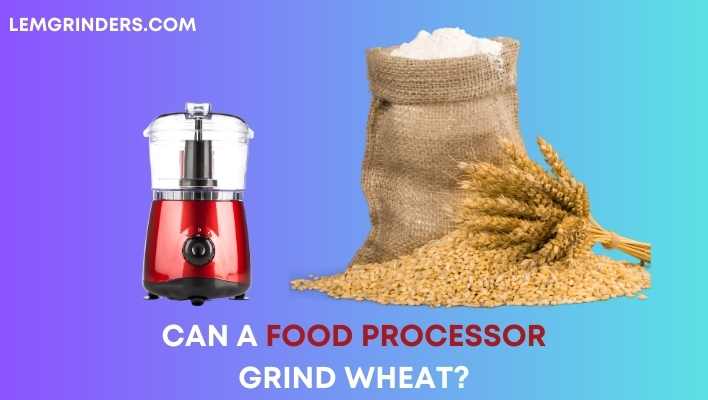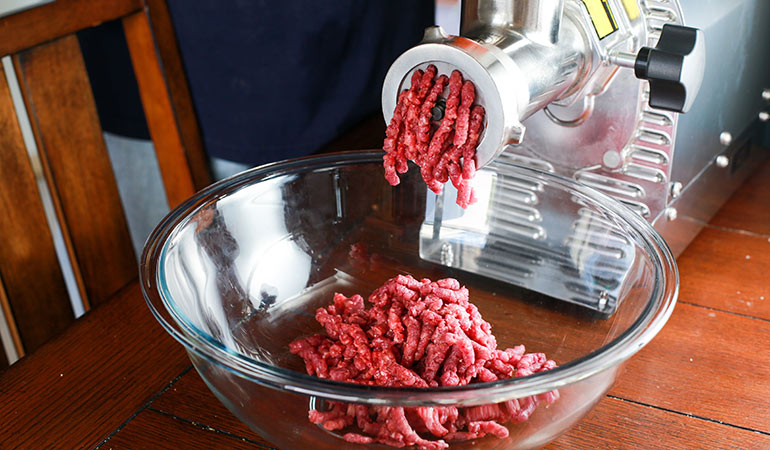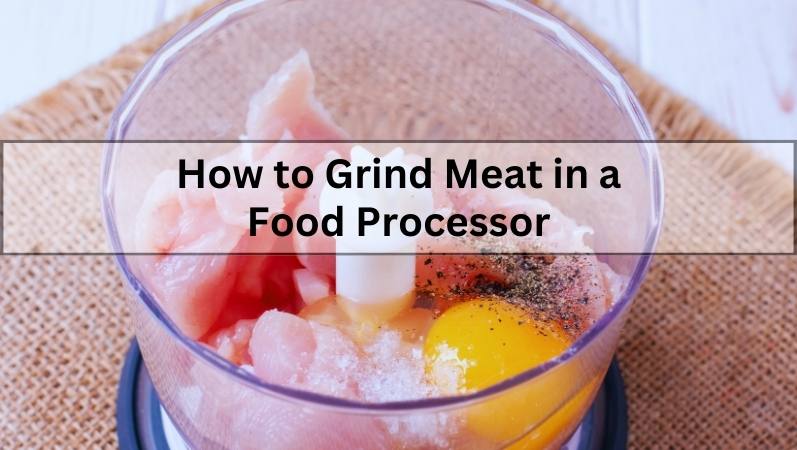Yes, a food processor can grind wheat.
Understanding The Mechanics Of Food Processors
Food processors have become essential kitchen appliances for many households as they offer a convenient way to prepare a wide variety of meals. When it comes to grinding wheat, you may wonder if a food processor can handle the task. In this article, we will delve into the mechanics of food processors and explore their components and capabilities, allowing you to better understand if a food processor can indeed grind wheat.
How Do Food Processors Work?
Food processors are designed to perform a range of tasks including chopping, slicing, shredding, pureeing, and blending. They consist of several components that work together to achieve these functions in an efficient manner.
The main component of a food processor is the motor, which powers the appliance and drives the blades. The motor is typically housed in the base of the unit and is responsible for providing the necessary power to perform the desired functions.
Attached to the motor is a circular bowl that holds the ingredients to be processed. This bowl often has a feed chute through which you can add the ingredients while the processor is running. The design of the bowl allows the ingredients to be evenly distributed and processed effectively.
At the bottom of the bowl, you’ll find an S-shaped blade assembly. This assembly consists of a stationary blade that remains in place and a spinning blade that rotates when the motor is active. When the blades spin, they chop, blend, or grind the ingredients, depending on the desired outcome.
Additionally, food processors may come with various attachments such as slicing discs, shredding discs, and dough blades. These attachments expand the capabilities of the processor, allowing you to perform even more tasks with ease.
Exploring the Components and Capabilities of a Food Processor
Now that we know how food processors work, let’s explore their components and capabilities in detail. Below is a breakdown of each component and its function:
| Component | Function |
|---|---|
| Motor | Provides the power to drive the blades and perform various functions. |
| Bowl | Holds the ingredients and allows for even distribution during processing. |
| S-shaped Blade Assembly | Chops, blends, or grinds the ingredients to achieve the desired outcome. |
| Attachments (slicing discs, shredding discs, dough blades, etc.) | Expand the capabilities of the processor for slicing, shredding, kneading dough, and more. |
Food processors are versatile kitchen appliances that can tackle a wide range of tasks. While they are primarily designed for chopping and blending, some food processors do have the capability to grind wheat. However, it’s worth noting that food processors may not achieve the same fine consistency as a dedicated grain mill. Therefore, if you require finely ground wheat flour, it may be best to invest in a specific grain mill instead. Nonetheless, food processors still offer a convenient option for grinding wheat in a pinch.
In conclusion, food processors are a valuable addition to any kitchen. Understanding their mechanics and components allows you to make informed decisions about their capabilities, including whether they can effectively grind wheat. So, if you’re in need of a versatile kitchen appliance that can handle various tasks, a food processor may just be the perfect choice.
The Power Of Grinding: Unlocking The Potential Of Your Food Processor
When it comes to kitchen appliances, food processors are an indispensable tool for any cooking enthusiast or home chef. Not only do they make prepping ingredients quick and effortless, but these versatile machines can also perform a variety of culinary tasks. One of the most underrated features of a food processor is its ability to grind ingredients to perfection. From grains and seeds to nuts and spices, a food processor can help you unlock the full potential of your recipes by transforming whole ingredients into fine powders. In this article, we’ll explore the different aspects of grinding with a food processor, starting with a popular question: Can a food processor grind wheat?
Can A Food Processor Grind Wheat?
Yes, a food processor can indeed grind wheat to create your own fresh and wholesome flour at home. Whether you prefer to make bread, pastries, or pasta from scratch, grinding your own wheat allows you to control the texture and quality of your flour. With the sharp blades and powerful motor of a food processor, you can easily grind whole wheat kernels into fine flour, just like the store-bought varieties. By having control over the grinding process, you can ensure that the resulting flour retains its nutritional value and adds a delightful freshness to your culinary creations.
Other Grains and Seeds You Can Grind with a Food Processor
Aside from wheat, a food processor offers endless possibilities when it comes to grinding various grains and seeds. From rice and oats to corn and quinoa, your food processor can effortlessly grind a wide range of whole grains, allowing you to experiment with new flavors and textures in your cooking. Additionally, seeds like flaxseed and chia seeds can also be ground in a food processor, making it easier for your body to absorb their nutritious benefits. By grinding your own grains and seeds, you not only unlock their full potential but also introduce a fresh and vibrant element to your dishes.
Transforming Nuts and Legumes into Fine Powders
Besides grains and seeds, a food processor can also transform nuts and legumes into fine powders. Whether you want to add almond flour to your baking recipes or create a smooth and creamy nut butter, the grinding function of your food processor comes to the rescue. By blending nuts and legumes at high speeds, the food processor breaks them down into a fine powder consistency, making them easier to incorporate into your recipes. This opens up a world of possibilities for those with dietary restrictions or those seeking alternative ingredients in their cooking.
Grinding Herbs and Spices for Enhanced Flavor
Finally, a food processor is an ideal tool for grinding herbs and spices. By breaking down fresh herbs like basil, cilantro, or parsley, you can create flavorful and aromatic blends to elevate your dishes. Similarly, whole spices such as cumin, peppercorns, or cinnamon can be ground into a fine powder, amplifying their aroma and flavor. With a food processor, you can say goodbye to store-bought spice blends and embrace the fresher and more vibrant taste of homemade herb and spice powders.
In conclusion, the power of grinding with a food processor cannot be underestimated. From grinding wheat to transforming grains, seeds, nuts, legumes, herbs, and spices into fine powders, a food processor opens up a world of culinary possibilities. With a few quick pulses, you can unlock the full potential of your ingredients and take your cooking to new heights. So why settle for pre-ground ingredients when you can experience the freshness and control of grinding with a food processor?
Tips And Techniques For Grinding Wheat With A Food Processor
Grinding wheat at home has never been easier, thanks to the versatility of a food processor. Whether you’re looking to make fresh flour for your favorite bread recipe or want to experiment with different textures for your baked goods, a food processor can be a valuable tool. In this blog post, we will explore some valuable tips and techniques to help you achieve optimal results when grinding wheat with a food processor. Let’s dive in!
Selecting the Right Type of Wheat for Grinding
Choosing the right type of wheat is crucial for achieving the desired texture and flavor in your flour. There are several varieties of wheat available, each with its distinct characteristics. Some common types include hard red wheat, soft white wheat, and durum wheat. Here’s a breakdown of the different types:
| Type of Wheat | Characteristics |
|---|---|
| Hard Red Wheat | Higher protein content, ideal for making whole wheat bread |
| Soft White Wheat | Lower protein content, perfect for baking pastries, cakes, and cookies |
| Durum Wheat | High gluten content, best for making semolina flour and pasta dough |
Based on your specific needs and preferences, choose the right type of wheat before proceeding with the grinding process.
Preparing the Wheat Grains for Optimal Results
Before grinding the wheat, it’s essential to prepare the grains to ensure optimal results. Follow these steps to prepare the wheat grains:
- Clean the wheat grains thoroughly to remove any dirt or impurities.
- Rinse the grains under running water and pat them dry using a clean towel.
- Transfer the dry grains to a large bowl and soak them in water for a few hours or overnight. This step helps soften the grains and enhances the grinding process.
- Drain the soaked grains and spread them out on a clean towel to dry completely.
By following these preparation steps, you’ll ensure that your wheat grains are ready for efficient grinding.
Using Different Blades and Attachments for Specific Textures
A food processor offers various blades and attachments that can be used to achieve different textures when grinding wheat. Here are some options you can explore:
- Standard Blade: This blade is suitable for general-purpose grinding, producing a medium-fine texture.
- Steel Blade: If you desire a more fine and powdery texture, the steel blade is a great option.
- Disk Attachment: Use the disk attachment with larger holes for a coarser texture, ideal for recipes like couscous or cracked wheat.
Experimenting with different blades and attachments will allow you to create the perfect texture for your specific culinary needs.
Understanding the Recommended Grinding Time and Speed
When grinding wheat with a food processor, it’s essential to understand the recommended grinding time and speed for optimal results. Grinding for too long can lead to overheating and affect the quality of the flour. Here are some general guidelines:
- Grinding Time: Start by grinding the wheat grains in short bursts of 10-15 seconds, allowing the processor to rest between each grind. Repeat the process until you achieve the desired texture.
- Grinding Speed: Opt for a low or medium speed setting on your food processor while grinding wheat. Higher speeds may generate excessive heat and affect the quality of the flour.
By following these recommendations, you can ensure that your flour is ground to perfection with a food processor.
Grinding wheat with a food processor opens up a world of possibilities in your kitchen. Use these tips and techniques to enhance your grinding experience and create homemade flour that adds a delightful touch to your favorite recipes. Happy grinding!
Enhancing Your Culinary Repertoire With Freshly Ground Wheat
Freshly ground wheat flour is a culinary game-changer, adding a wholesome and flavorful touch to your dishes. Whether you are a seasoned baker or an adventurous home cook, incorporating freshly ground wheat into your repertoire opens up a world of possibilities. With the help of a food processor, you can effortlessly grind your own wheat at home and unlock its full potential. From baking delicious homemade bread to creating nutritious and versatile wheat-based recipes, and even incorporating freshly milled flour in everyday cooking, let’s explore the many ways you can elevate your culinary endeavors with this versatile ingredient.
Baking Delicious Homemade Bread with Freshly Ground Wheat Flour
There’s nothing quite like the aroma of freshly baked bread wafting through your kitchen. By grinding your own wheat flour with a food processor, you can effortlessly take your bread-making skills to the next level. The result is a loaf that boasts a rich flavor and a unique texture that store-bought flour simply cannot match. Plus, with the ability to control the coarseness of your freshly ground flour, you can experiment with different varieties of wheat, such as hard red or soft white, to customize your bread to perfection.
Creating Nutritious and Versatile Wheat-based Recipes
Wheat is a nutritional powerhouse, packed with essential vitamins, minerals, and fiber. By grinding your own wheat with a food processor, you can unlock its full nutritional potential. From wholesome pancakes and hearty muffins to nutritious pasta and flavorful flatbreads, freshly ground wheat flour can elevate any wheat-based recipe. By using fresh flour, you ensure that your meals are not only delicious but also higher in nutritional value compared to using pre-packaged flour. Take your cooking to new heights by incorporating this nutritious ingredient into your favorite recipes.
Incorporating Freshly Milled Flour in Everyday Cooking
Freshly milled flour isn’t just reserved for baking. With a food processor in your kitchen arsenal, you can effortlessly incorporate freshly milled flour into your everyday cooking. Use it to thicken sauces, create homemade gravies, or add a nutty flavor and pleasant texture to coatings for meats and vegetables. You can even substitute a portion of all-purpose flour with your freshly ground wheat flour in recipes like pancakes, waffles, and muffins to enhance the nutritional profile and compose a unique flavor profile. Don’t limit yourself to baking alone – explore the versatility of freshly ground wheat flour in your day-to-day cooking.
Maintenance And Care For Your Food Processor
When it comes to owning a food processor, regular maintenance and proper care are essential to ensure its longevity and efficient performance. In this section, we will discuss the best practices to clean and store your food processor, as well as troubleshoot common issues that may arise.
Cleaning and Storage Tips for Prolonged Usage
Keeping your food processor clean is vital to prevent cross-contamination and maintain its optimal functioning. Here are a few cleaning and storage tips:
- Disassemble the Parts: Before cleaning, make sure to disassemble all removable parts of the food processor.
- Hand Wash or Dishwasher: Most food processor parts are dishwasher-safe. However, check the manufacturer’s instructions to ensure which parts can be safely washed in a dishwasher and which require handwashing.
- Gentle Scrubbing: Use a soft sponge or dishcloth to gently scrub the parts, avoiding abrasive cleaners that can scratch the surfaces.
- Dry Thoroughly: After washing, dry all the parts completely before reassembling or storing. Moisture left on the components can lead to mold or rust.
- Store Properly: Once dry, store the food processor in a clean and dry cabinet or pantry, away from direct sunlight or excessive heat.
Troubleshooting Common Issues with Food Processors
Despite regular maintenance, food processors may encounter occasional issues. Below are some common problems you might face and suggestions for troubleshooting:
| Issue | Solution |
|---|---|
| The Food Processor Won’t Start | 1. Check if the power cord is properly connected. 2. Make sure the bowl and lid are correctly locked in place. 3. Examine the motor overload protection feature and wait for it to reset if triggered. |
| Excessive Vibrations or Noisy Operation | 1. Ensure the food processor is placed on a stable and level surface. 2. Check if the blade or other attachments are securely fastened. 3. Inspect for any loose or broken internal components and contact customer support if necessary. |
| Poor Grinding or Chopping Results | 1. Confirm that the food processor is not overloaded with ingredients. 2. Adjust the processing time for better results. 3. Sharpen or replace dull blades as needed. |
| Leaks or Seepage | 1. Ensure the rubber gasket is properly seated and undamaged. 2. Tighten any loose fittings or screws. 3. Replace the worn-out gasket if necessary. |
By following these maintenance and troubleshooting guidelines, you can maximize the lifespan of your food processor and enjoy its efficient performance for years to come.
Frequently Asked Questions Of Can A Food Processor Grind Wheat
Can You Use A Food Processor To Grind Flour?
Yes, a food processor can be used to grind flour easily and efficiently.
What Can I Use To Grind Wheat?
You can use a wheat grinder to grind wheat into flour.
How Do You Grind Wheat Without A Grinder?
To grind wheat without a grinder, use a mortar and pestle or a blender to crush it.
What Can I Use To Grind Wheat Into Flour?
A grain mill is a helpful tool to grind wheat into flour.
Conclusion
After careful analysis and research, it is evident that a food processor can indeed grind wheat effectively. This versatile kitchen appliance is not only designed for chopping, blending, and pureeing but also has the capability to tackle various grains, including wheat.
With its powerful motor and different attachment options, a food processor can effortlessly grind wheat into flour, opening up a whole new world of possibilities for home bakers and cooks. From freshly ground whole wheat flour for bread to homemade wheat cereal or even homemade wheat protein powder, the possibilities are endless.
The convenience and efficiency of using a food processor for grinding wheat make it a valuable addition to any kitchen. So, if you’re wondering whether a food processor can handle wheat, the answer is a resounding yes! Take advantage of this multitasking appliance and elevate your culinary skills to new heights.






